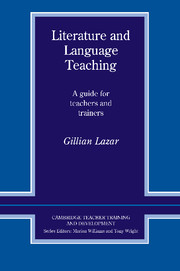Book contents
- Frontmatter
- Contents
- Thanks
- Acknowledgements
- Introduction
- 1 Using literature in the language classroom: The issues
- 2 Approaches to using literature with the language learner
- 3 Selecting and evaluating materials
- 4 Reading literature cross-culturally
- 5 Materials design and lesson planning: Novels and short stories
- 6 Materials design and lesson planning: Poetry
- 7 Materials design and lesson planning: Plays
- 8 Reflecting on the literature lesson
- 9 Literature and self-access
- Answer key
- Trainer's notes
- Bibliography
- Appendix: Eveline by James Joyce
- Index
1 - Using literature in the language classroom: The issues
Published online by Cambridge University Press: 04 May 2010
- Frontmatter
- Contents
- Thanks
- Acknowledgements
- Introduction
- 1 Using literature in the language classroom: The issues
- 2 Approaches to using literature with the language learner
- 3 Selecting and evaluating materials
- 4 Reading literature cross-culturally
- 5 Materials design and lesson planning: Novels and short stories
- 6 Materials design and lesson planning: Poetry
- 7 Materials design and lesson planning: Plays
- 8 Reflecting on the literature lesson
- 9 Literature and self-access
- Answer key
- Trainer's notes
- Bibliography
- Appendix: Eveline by James Joyce
- Index
Summary
The emphasis in this chapter is mainly on exploring some of those underlying issues and concerns relevant to using literature with the language learner. It is not the aim of this chapter to focus on the development of materials for immediate use in the classroom, although many of the points raised in this chapter will have a bearing on what approaches and materials are finally selected. Rather, a number of thoughts and ideas are raised for reflection and discussion. Some of these thoughts and ideas should help in making more principled and coherent classroom decisions about why and how to use literature in language lessons. However, ideas generated in this chapter will not help to pinpoint the definitive, right or correct way to teach or use literature. This is because every teaching situation is different, every literary text is different and every theory explaining literature itself or how to use it in the classroom is different. The task for teachers is thus to draw on the range of insights available, and then to develop an approach appropriate and relevant to their students.
What is literature?
In this section we think about some of the possible ways of defining literature. This will enable us to focus on some of the implications of using literature with the language learner.
Task 1
A group of teachers from all over the world were each asked to write down a definition of literature. Read through their definitions and then write down your own definition of literature.
- Type
- Chapter
- Information
- Literature and Language TeachingA Guide for Teachers and Trainers, pp. 1 - 21Publisher: Cambridge University PressPrint publication year: 1993

